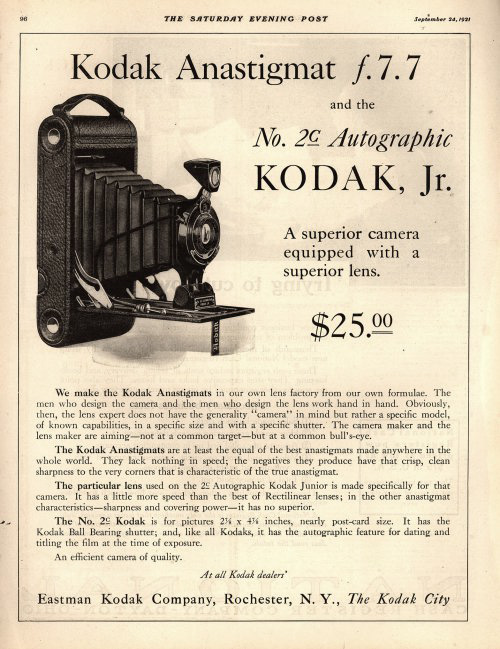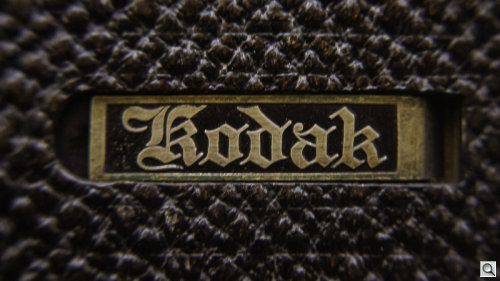Photo Corners headlinesarchivemikepasini.com
![]()
A S C R A P B O O K O F S O L U T I O N S F O R T H E P H O T O G R A P H E R
![]()
Enhancing the enjoyment of taking pictures with news that matters, features that entertain and images that delight. Published frequently.
Friday Slide Show: No. 1A Autographic Kodak Jr.




21 September 2018
With Photokina 2018 coming up next week, we thought we'd have a little fun with the oldest camera in the bunker, a 1920s No. 1A Autographic Kodak Jr. After all, once upon a time, it was state of the art, too.
And you can still buy one and even shoot with it. But why you would want to do that escapes us.
Our excuse for possession of this rather elegant photographic tool is that it belonged to our grandfather who, as a young man in the 1920s, was the guy who took photos of everybody partying at the Russian River or playing golf.
These macro images were taken with an Olympus E-PL1 and a Lensbaby Tilt Composer with a +10 macro attachment at f13. They were processed in Lightroom Classic CC. And, fun as it was, there was no party.
HIGHLIGHTS
Gramps always liked to have the latest and greatest gear whether it came to golf clubs, banjos or cameras. His No. 1A had the new f7.7 lens (that was fast in those days) and the Kodak Ball Bearing shutter (still lovely to hear).
Highlights of the No. 1A include:
- A-116 Autograph Film
- 1/25, 1/50 and 1/100 "instantaneous" exposures
- Bulb and Time exposures
- Compact size, folding bellows
- Fast f7.7 anastigmatic lens
- Ball bearing shutter
- Focus scale
- Remote release

The cross-shaped optical viewfinder, incidentally, provides a view of the crop for either a landscape or portrait orientation.
AUTOGRAPHS
So how do you autograph the film? We'll just quote from the manual:
7. -- The Autographic Feature
The Autographic Kodak has a spring door on the back, covering a narrow slot through which the writing is done upon the red paper. The slot is provided with an automatic safety spring border which operates when the door is open to press the papers into contact with the back of the film, thus securing the sharp printing of the image of the writing and preventing the diffusion of light around the edges of the slot. This slot is locates so that normally the writing comes between the exposures.
THE OPERATION.
Afte the picture is taken, push back the sliding lock with the thumb, in the direction indicated by the arrow. Open the door. Use the stylus, or a smooth pointed pencil, held in as upright a position as is convenient, and write on th strip of exposed red paper any memorandum desired, such as the title of the picture, the date, or details in regard to the exposure, light, stopes, etc.
To get a clear impression, press firmly on both up and down strokes. While writing or afterwards the sun should not be allowed to shine upon the paper. The action of the pencil or stylus so affects the tissue as to permit the light to record the writing upon the film. After finishing writing the door should be left open for the printing, in accordance with the following table:
(Expose to sky, but not to the sun.)
OUT OF DOORS INDOORS CLOSE
TO WINDOWBRILLIANT LIGHT 2 to 5 Seconds 5 to 7 Seconds DULL LIGHT 5 to 10 Seconds 10 to 15 Seconds INCANDESCENT LIGHT, dinstance 2 inches 30 to 60 seconds.
WELSBACH LIGHT, distance 6 inches, 30 to 60 seconds.
- Lock th edoor before winding a new film into place.
- Caution. In order to locate the writing accurately in the space between the negatives, it is important that the film should be turned so that the exposure number centers perfectly in the red window of the Kodak.
If a pencil is used, the point must be dry and it must be of the "indelible" variety.
If nothing else, the manual's instructions demonstrate what a hassle it has always been to provide any kind of metadata for film cameras.
SPECIFICATIONS
Specifications (squeezed into our modern format) for the No. 1A include:
NO. 1 AUTOGRAPHIC KODAK JUNIOR SPECIFICATIONS Sensor A-116 film Viewfinder Optical Shutter 1/25, 1/50 and 1/100 second marks
B and T detents
Ball bearings
Remote release includedISO ISO 200 Autofocus Focusing scale near bellows Live View In a sense Flash Not built-in Movie No [cf. Thomas Edison] Connectivity Handstrap
Two tripod mounts (landscape, portrait)Power Hand cranked Dimensions 4 x 8 x 2.5 inches Weight 1 lb.
16-80mm KIT LENS SPECIFICATIONS Focal Length 130mm Minimum Focus 6 feet Aperture f7.7 to f45 Optical Design Apparently Autofocus No Image Stabilization No Filter Thread 24.9mm PRICE, AVAILABILITY
The manual once sold for 10 cents. We did find a "severely" limited source for the A-116 film (although you can use 120 film) and we even found a camera for sale for $30 on eBay.
But our advice is to wait until you see what Photokina reveals.
